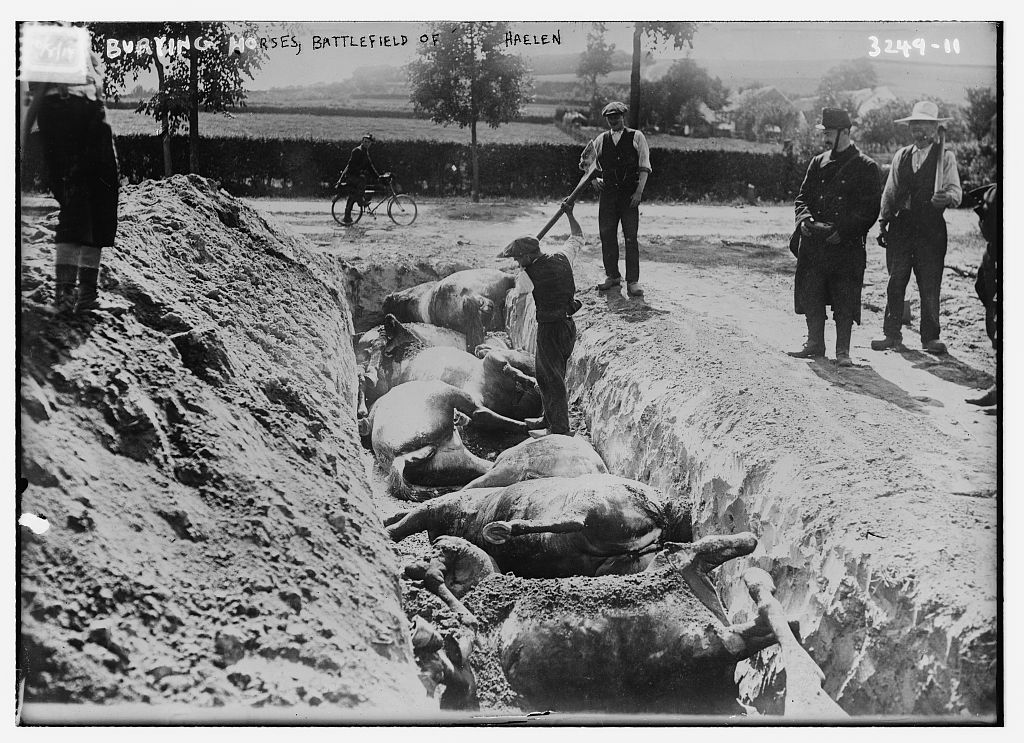Page 4 of 4
Re: Battlefield Horse Carcasses
Posted: Mon Aug 27, 2012 11:02 am
by Centman
British Army Farriers were tasked with cutting off the front hooves as that had the Regtl Initials on one and the horses number on the other, you wouldnt get a replacement mount without a set of hooves to prove the horse was dead. The Farriers still carry the ceremonial axe on the Trooping of The Colour.
What suprises me in these phots is the absence of wounds, could it be that these animals were killed by blast?
Apologies for not reading the whole thread, but I have seen an account where they had in effect a processing system to salvage every bit of flesh, fat, bone and sinew that they could from dead horses.
Re: Battlefield Horse Carcasses
Posted: Mon Aug 27, 2012 5:10 pm
by Couvi
I believe the French had a plant run on manure-produced methane that tanned the horse hides and rendered the fat to make soap and explosives. You have to have a lot of dead horses to accomplish this and a lot of people who don’t object to the smell.
Re: Battlefield Horse Carcasses
Posted: Mon Aug 27, 2012 6:20 pm
by Pat Holscher
Probably every army had disposal systems at garrisons, or at least garrisons with large numbers of horses. Ft. Riley, for example, had crematories for horses. An older panograph we have up on the forum somewhere shows smoke them, along with the garrison, with smoke rolling over the Ft. Riley skies. Anyhow, we we're talking about the French examples above, is this in relation to WWI or to peacetime conditions?
Probably the most common battlefield solution is the one shown in the photo immediately above in this thread. Dig a hole, and drag them in.
Re: Battlefield Horse Carcasses
Posted: Tue Aug 28, 2012 2:53 am
by Centman
Pat Holscher wrote: Anyhow, we we're talking about the French example, is this in relation to WWI or to peacetime conditions?
Probably the most common battlefield solution is the one shown in the photo immediately above in this thread. Dig a hole, and drag them in.
It was a WWI facility, specifically set up to deal with horse carcasses, I will try and locate it, I only came across it by chance some months ago.
Re: Battlefield Horse Carcasses
Posted: Thu Apr 11, 2013 9:56 pm
by Pat Holscher
Re: Battlefield Horse Carcasses
Posted: Fri Apr 12, 2013 8:18 am
by Pat Holscher
Re: Battlefield Horse Carcasses
Posted: Thu Jun 13, 2013 6:49 am
by Pat Holscher
Re: Battlefield Horse Carcasses
Posted: Mon Aug 12, 2013 7:34 am
by Pat Holscher
Pat Holscher wrote:
Bumped up in light of item posted on today's calendar by Jan (for August 12).
Re: Battlefield Horse Carcasses
Posted: Mon Aug 12, 2013 8:32 am
by jan
On the roads leading out Haelen towards the battlefield, the Belgian army build some improvised barrikades made of cut down trees and carts, these photos were taken the day after the battle, dead German cavalry horses still lying there. The Belgian soldiers are from the Guides Brigade, they did not participate in the battle on august 12, but kept mounted in reserve at the southern edge of the actual battlefield. It were the two dismounted Lancer regiments together with the guns of the Horse artillery and some cyclists that repulsed the German charges. Most of the charges however were made over open fields in the direction of a large farmhouse (named "de IJzerwinning") that still stands today in the centre of the battlefield.


Jan
Re: Battlefield Horse Carcasses
Posted: Sat Nov 23, 2013 8:48 am
by Philip S
Re: Battlefield Horse Carcasses
Posted: Tue Dec 10, 2013 7:24 pm
by noman
After the Battle of Seven Pines 1862 VA the dead horses were burned
July 1863 Gettysburg dead horses
http://www.americancivilwarphotos.com/c ... rg?page=10
After the Battle of Little Bighorn 1876 -there is a trench for Horse bones on Custer last Stand Hill



